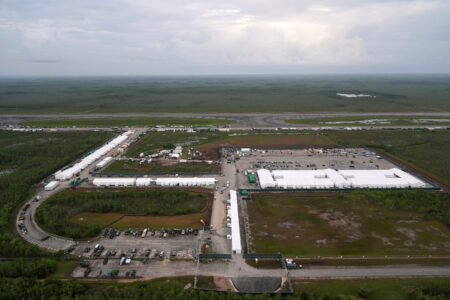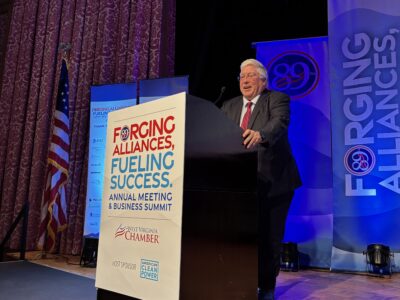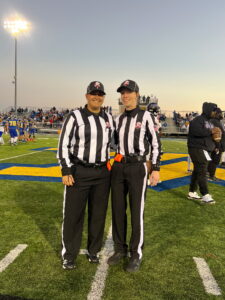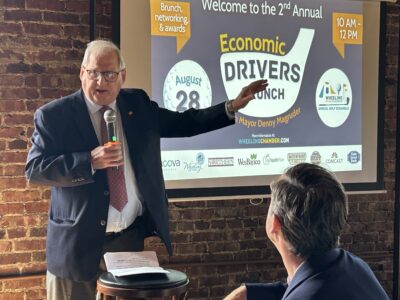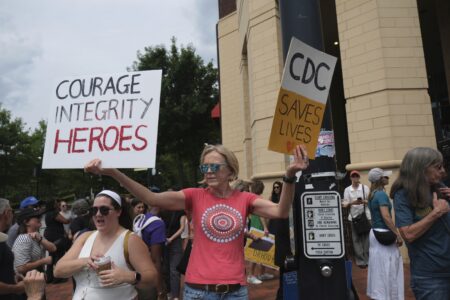Public Weighs In on Planned ‘Heritage Experience’ Exhibit at Future Wheeling Gateway Center

photo by: Emma Delk
Wheeling resident Spencer Porter shares ideas for the future Wheeling Gateway Center’s immersive Heritage Experience on Tuesday during a gathering in the Capitol Theatre ballroom.
WHEELING — Interested residents gathered at the Capitol Theatre Ballroom on Tuesday evening to share what pieces of Wheeling history they want included in the Wheeling Gateway Center’s immersive Heritage Experience.
The Heritage Experience will be an adaptable exhibit in the Gateway Center, utilizing digital storytelling and technology to bring Wheeling’s history to life. TimeLooper was the design firm selected by the Wheeling-Ohio County Convention and Visitors Bureau to create the approximately 4,000-square-foot exhibit.
Andrew Feinberg, principal and co-founder of TimeLooper, said the exact placement of the exhibit and its “final contours” are still in development with the project manager, Tipping Point.
The exhibit is planned for the main floor of the center, overlooking the Ohio River and the Wheeling Suspension Bridge.
“The exhibit is going to have prime real estate overlooking the river and the suspension bridge because those transportation hubs are central to one of the defining moments in Wheeling’s early history,” Feinberg said. “They have to sit at the center of the story that’s going to be told.”
Before attendees shared what stories they wanted told in the exhibit, Tipping Point Director of Construction Eric Heinowitz shared feedback from the first community engagement session for the project held in February 2024.
More than 4,200 respondents gave feedback for the project. The top priorities for the center identified were connectivity to the trail and riverfront, local heritage experiences and an elevated culinary and bar experience.
Heinowitz presented renderings of the center created by Desmone Architects that incorporated this feedback. He said Tipping Point was about halfway through the design development stage, which then led them to the next step of beginning work on the Heritage Experience.
“In the next six months, we are excited to continue to do the design development, which will lead to construction-level drawings,” Heinowitz said. “We’ll put those construction drawings out to mid by late fall this year, and then construction contracts will probably be signed in early 2026 and construction shortly after that.”
Heinowitz said the Heritage Experience would not be a “typical museum” experience tied to physical artifacts. The focus of the exhibit will be on allowing visitors to “interact” with the city’s history, motivating them to explore Wheeling further.
“You’ll have some elements that you’ve seen in a typical museum, maybe a cut nail, but we really want you interacting with it, so you are excited by the history,” Heinowitz said. “Ultimately, the goal is to have you go and explore downtown, so it’s going to be a quick 10-to-15-minute experience where you’re going to be completely blown away by the technology that TimeLooper can bring to the table.”
Feinberg then shared TimeLooper’s objectives for the Heritage Experience space. Based on workshops with the CVB, the theme of the exhibition will be, “Wheeling has always been a city of momentum, a place where ideas spark, industries rise and communities thrive.”
Feinberg noted the insights and stories collected from residents during the meeting would sit at the center of the theme. He said it was TimeLooper’s job to “unearth the moments” that provide the “real color” to the city, not just the key markers of its history that would be found in a textbook.
“It’s really easy to use technology to create something that gains attention,” Feinberg added. “It’s really difficult to create something that reflects the community and that people who are passing through can engage with to understand how you identify yourselves. All of you must sit at the center of that story.”
In addition to centering residents’ stories in the exhibit, Feinberg said another goal was to be “very, very thoughtful” about how they would integrate pieces of material culture in a way to enhance the story, such as artifacts. An additional goal would be to ensure a “highly compelling visitor experience” for multiple trips to the center.
“We want to design the exhibit so that when your family comes to visit every six months, you, as a local, are not bored walking through the exhibit,” Feinberg said. “There would always be a reason for you to want to stop and look at it.”
To create and experience that is not “one and done,” Feinberg said they would “lean into the digital” during its creation. This includes using artificial intelligence to ensure all information that sits inside the museum is “accurate, historically relevant, trusted and verified.” This information will then be used in a “dynamic ecosystem” to present it to visitors and allow them to request the content they are interested in seeing at the exhibit.
“We’re presenting experiences that allow visitors to co-create in this journey, rather than just consuming information,” Feinberg said.
TimeLooper is currently in the concept development phase of the design process. The next phase will be the design development and pre-production phase, which will finalize the details for the interior of the exhibition and the experience. The last phase will be fabrication, production and installation to build the exhibit.
TimeLooper Creative Associate Petra Elfström then shared initial ideas the design firm had created for the project. This includes dividing Wheeling’s history into six chapters — Indigenous, Frontier, Transportation, Statehood, Industry and Culture — to allow visitors to explore different themes in Wheeling’s heritage.
“Rather than creating a fully comprehensive history of the city, which would take maybe a floor for each one of these chapters, we really want to inspire visitors to go out there and learn more through different activities, research and conversations with other residents,” Elfström said. “These chapters will provide more of a taste and inspiration, with a couple of stories for each of these themes.”
Elfström shared some tentative ideas for experiences for these chapters. This included projecting different types of transportation onto the Suspension Bridge, a nail-making machine for visitors to use and an interactive table of the layout of the city highlighting key industries.
“These are just early ideas of dreaming big of how we can make this experience different from any museum people have been to before and also propel them out of the building and into the real world to learn more and spend time and money in the community,” Elfström said.
After Elfström shared design ideas, the nearly 50 attendees at the presentation then shared what stories they wanted included in the exhibit. Audience members were invited to fill out sticky notes with individual experiences, whether that be a story, feeling or sentiment, that connect to one of the six chapters of Wheeling’s history.
“We’re really hoping to mine insights from all of you, so as you go over to these boards, please think about individual experiences that you hope to have,” Feinberg said. “Maybe you feel like there are parts to Wheeling’s story that we haven’t even touched on that you want to make sure get included. This is a moment for you to share all of those ideas with us.”
Heinowitz encourages anyone else who would like to share aspects of Wheeling’s history to include in the exhibit to email Tipping Point at createchange@tippingpointdev.com and include “Wheeling Gateway Center” in the subject line.
“We are really excited for the community to give feedback,” Heinowitz said. “Community engagement is a core value of Tipping Point, so every decision that we make for any development project we’re involved in, we put the community’s voice first. We just appreciate these opportunities to do that.”


